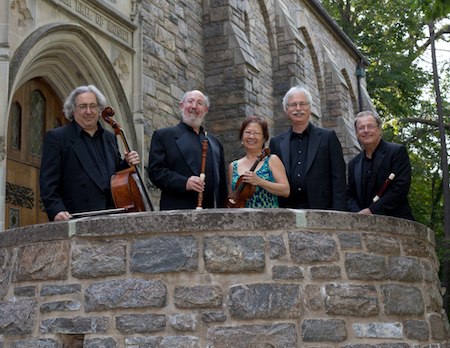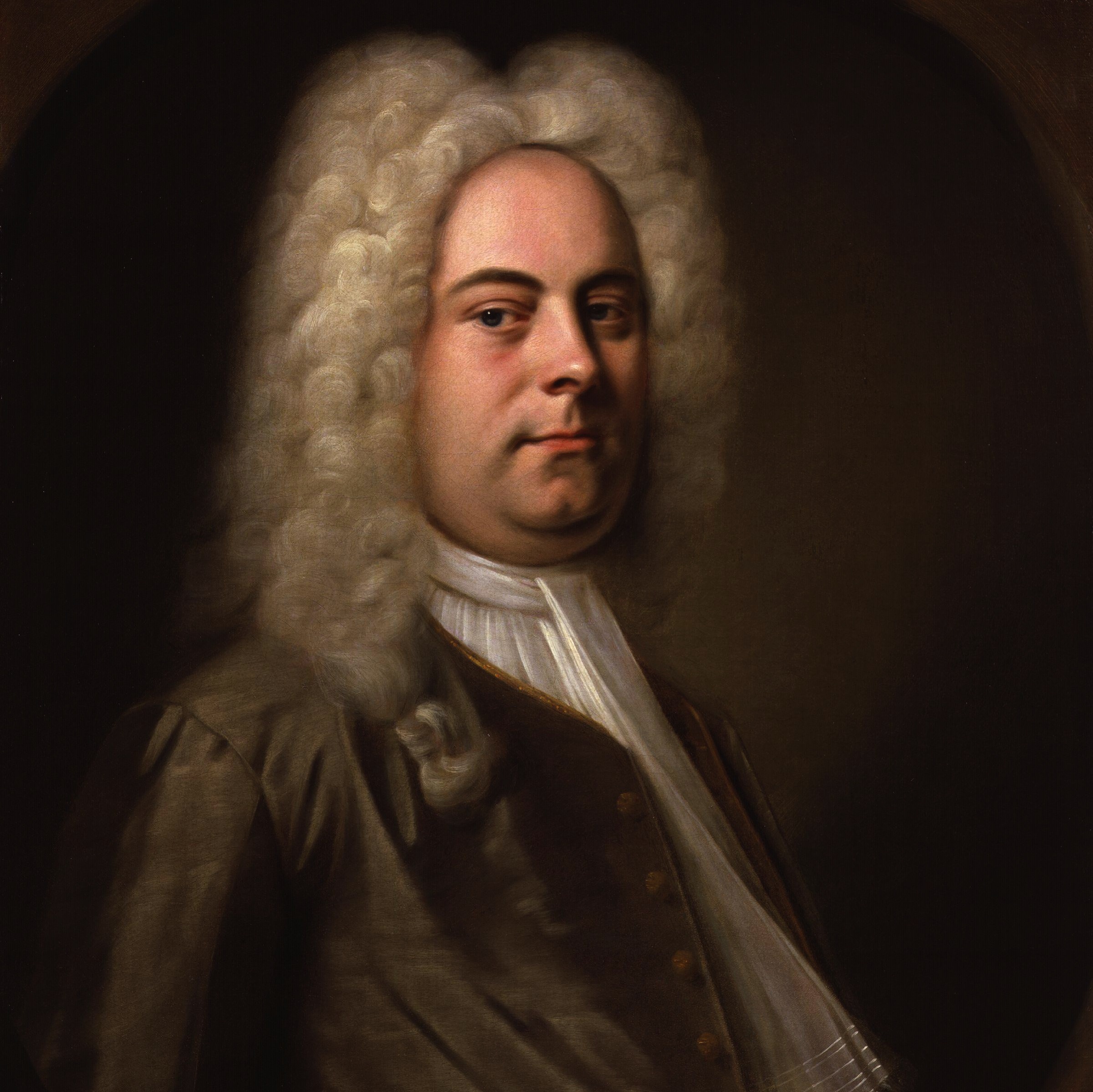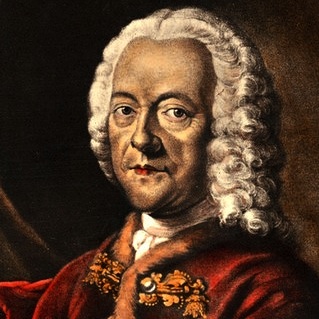
The SFEMS 2017–18 concert season gets underway the weekend of October 20–22, with performances by one of the first American “original instrument” ensembles. Formed in 1973 by five Juilliard graduates, the Aulos Ensemble was on the cutting edge of the early music movement at a time when historical performance was starting to capture the imagination of the American listening public. With its conservatory based training, Aulos brought an uncompromising standard of excellence in performance that resulted in invitations from virtually all of this country’s major chamber music presenters. This exposure helped create a new audience awareness for the rich rewards of this repertoire performed on “period instruments” and comments such as “scintillating,” “virtuosic,” and “authentic baroque performance at its best” from America’s most respected music critics.
Aulos’s program centers on the musical giant, George Frideric Handel, juxtaposed with two other composers he greatly admired, Henry Purcell and Georg Philipp Telemann. Handel was a complex figure, whose musical soul and world were woven together from experiences in three lands: Germany, Italy, and England. His Italian influence, understandably, has received great attention. However Handel was also a great admirer of Purcell and absorbed something of his great forebear’s extroverted, commemorative, characteristically English style. And he was at base also a German composer (J.S. Bach’s favorite, in fact). He was well trained in keyboard and counterpoint within the Lutheran church establishment. And he was guided by an independent and remarkably creative spirit, which led him to disobey his parents’ wishes and drop out of law school to become a composer, a resolution he made with fellow law student dropout Georg Philipp Telemann. Handel and Telemann became lifelong friends, remaining in touch and corresponding regularly after Handel relocated to London. The two even shared a passion for horticulture, and Handel sent Telemann plants from England!
Aulos provided the following notes on their upcoming concert:
“He was impetuous, rough and peremptory in his manners and conversation, but totally devoid of ill-nature or malevolence; indeed, there was an original humour and pleasantry in his most lively sallies of anger or impatience, which, with his broken English, were extremely risible… Handel’s general look was somewhat heavy and sour; but when he did smile, it was his sire the sun, bursting out of a black cloud. There was a sudden flash of intelligence, wit and good humour, beaming in his countenance, which I hardly ever saw in any other.”
—Charles Burney (1785)
 George Frideric Handel’s compositions mirror Burney’s description of his personality in their powerful expressions of mood and emotion. His music’s endless variety and inspiration resulted in a wide ranging career, first in his native Germany, then in Italy where he went to study and realized his first great successes, and finally in London where he became the most famous musician of his day. Writing in all the international styles prevalent at the time, he was afforded acclamation from patrons, critics, and audiences alike wherever his works were performed. He had the ability to immerse himself in a given style, absorb what it had to offer, and write within that style while still making his compositions totally personal. When he visited London for the first time in 1711 he found a public eager for his operas in the Italian style. Henry Purcell who had dominated London’s musical landscape for the first part of the 17th century died at the height of his career in 1695 at the young age of 36.
George Frideric Handel’s compositions mirror Burney’s description of his personality in their powerful expressions of mood and emotion. His music’s endless variety and inspiration resulted in a wide ranging career, first in his native Germany, then in Italy where he went to study and realized his first great successes, and finally in London where he became the most famous musician of his day. Writing in all the international styles prevalent at the time, he was afforded acclamation from patrons, critics, and audiences alike wherever his works were performed. He had the ability to immerse himself in a given style, absorb what it had to offer, and write within that style while still making his compositions totally personal. When he visited London for the first time in 1711 he found a public eager for his operas in the Italian style. Henry Purcell who had dominated London’s musical landscape for the first part of the 17th century died at the height of his career in 1695 at the young age of 36.
The foremost composer of restoration England, Henry Purcell has been called the greatest setter of English words that ever lived, and although he incorporated Italian and French stylistic elements into his compositions, his voice was unique and considered to be quintessentially English. Fairy Queen, one of his most famous compositions, is described as a masque or “semi-opera” and is based on Shakespeare’s A Midsummer Night’s Dream, though the libretto was not by Shakespeare. Written in 1692, the score is his longest for the theatre, and includes an overture, some symphonies, numerous dances, songs and entr’actes. The instrumental pieces are some of his finest and most familiar. His original orchestration included pairs of recorders, oboes, trumpets, and drums along with a string and continuo group. We’ve assembled a group of these “greatest hits” for our opening selection, arranging them for our Ensemble
Handel’s instrumental chamber music presents far greater challenges in dating and authenticating than his operas and oratorios. The two trio-sonatas on our program—Opus 2, no.1 in B minor (HWV 386b) and Opus 2, no.8 in G minor (HWV 393) first appeared in an edition under the imprint of Jeanne Roger of Amsterdam around 1730. Winton Dean, the noted Handel authority, speculates that this was a bootleg edition as the sonatas were printed a few years later with the correct title page by John Walsh (Handel’s frequent publisher) in an edition in 1733. The dates of composition however were probably earlier—they were likely written between 1717 and 1719, while Handel was at Cannons. Indeed the final movement of HWV 386b exists in the Chandos Anthems. These sonatas are all written in the 4 movement sonata da chiesa form with pairs of movements (slow-fast, slow-fast), often linked by half-cadences with the third movement written in a different key. The Walsh title page mentions “violins, flutes, or oboes” which was typical of the time—though the B minor trio expressly mentions flute. Many of the sonatas go outside the range of the 18th-century woodwinds but the G minor sonata (HWV 393) fits the compass of the baroque oboe perfectly, and we perform it with this instrumentation.
 The Concerto a Quattro in D minor has been attributed to Handel but its authorship cannot be verified. Along with its companion piece in D major it was discovered in a manuscript entitled “2 Concertos par le sieur Händel” in a private music library of the Count Schönborn at Weisentheid-Unterfranken in Bavaria by the musicologist Fritz Zobeley. Regardless of its origin, the D minor Concerto, with an obbligato cello part at once virtuosic in the second movement and expressive in the third, is a lovely work and a valuable addition to the mixed chamber music of the period. Curiously, the first movement closely resembles that of Handel’s G minor oboe concerto (HWV 287) with its dotted figures in the violin and cello, over which the solo flute plays a melody complete with Italianate ornamentation.
The Concerto a Quattro in D minor has been attributed to Handel but its authorship cannot be verified. Along with its companion piece in D major it was discovered in a manuscript entitled “2 Concertos par le sieur Händel” in a private music library of the Count Schönborn at Weisentheid-Unterfranken in Bavaria by the musicologist Fritz Zobeley. Regardless of its origin, the D minor Concerto, with an obbligato cello part at once virtuosic in the second movement and expressive in the third, is a lovely work and a valuable addition to the mixed chamber music of the period. Curiously, the first movement closely resembles that of Handel’s G minor oboe concerto (HWV 287) with its dotted figures in the violin and cello, over which the solo flute plays a melody complete with Italianate ornamentation.
The Chaconne from Terpsicore (HWV 8b) must have been one of Handel’s favorite pieces judging from the number of times that it appears in his various compositions. Tracing the different versions gives us insight into his processes for assembling compositions and his imagination in seeing things in different contexts. In 1734 Handel revised his Il Pastor fido (HWV 8c) adding to it a suite of dances taken from his Parnasso in festa (HWV 73) written earlier that year. The result was Terpsicore, written for a dance troupe led by the great ballerina Marie Sallé, as a new prologue to the opera. It is this version in A major which we’ve used for this recording. In Handel’s earlier version, the dance is set as a chorus, also in A major, complete in and of itself but with a four-part chorus overlaid on the dance music, much in the same way Bach reset parts of his First Brandenburg Concerto into a cantata. Handel wrote the piece at least one other time—as part of the Trio-Sonata Opus 5, no.4, (HWV 399) in G major where he also recycled other movements from Athalia, and Il Pastor fido. Although published in a collection of trio-sonatas, Handel outfitted this work with the added viola part from his other versions. It is interesting to note the inconsistencies among the 3 versions—accidentals and even phrase lengths vary from one to another. For our performance we have substituted a flute for one of the two oboes, and expanded and contracted our forces at different times from that of a trio-sonata texture to one approximating the orchestral versions—however we’ve left out the chorus.
Handel and Telemann maintained a long and close friendship as evidenced by the existence of correspondence between the two. While Telemann was just a teenager he visited Handel in Halle and their relationship continued as their careers blossomed. Both were enthusiastic botanists, and in 1750, Handel sent Telemann “a crate of flowers, which experts assure me are very choice and of admirable rarity.” Handel subscribed to the publication of Telemann’s Musique de Table in 1733, and borrowed many of Telemann’s ideas from those compositions in his own works, much as he did with his own music. His admiration for his friend’s talent can be seen in the joking reference that Telemann “could write a church piece in eight parts with the same expedition another would write a letter.”
 The Nouveaux Quatuors (commonly referred to as the Paris Quartets) from which our E minor Quartet is taken is one of his best-known collections. The quartets are remarkable not only for their instrumentation—instead of 3 treble instruments with a basso continuo, he gives us an obbligato of flute, violin, and viola da gamba or cello accompanied by the bass—but for their thorough immersion in and mastery of French style. Beginning with a piece in the style of a French Ouverture (a slow, dotted introduction followed by a fast section, concluding with the opening material), Telemann follows with movements in the typical form of a Suite but instead of purely dance movements, he gives us character pieces instead. The 2nd movement Gai is really a gavotte and Telemann uses the usual three-part structure with a section in minor, followed by a contrasting section in major and concluding with a da capo. A Vite in the relatively uncommon time signature of 6/4 is followed by a lovely E major air in binary form titled Gracieusement. The final two movements boast compelling character and are largely responsible for the almost iconic stature of this work in the canon of baroque chamber music. Distrait (loosely translated as ‘imprudent’) is a fiery piece in triple time, sharing the same three-section structure as the 2nd movement. But here the 2nd section remains in E minor, and features highly virtuosic writing for all the instruments along with a syncopated figure that adds an almost manic quality to the proceedings. The final movement, Modéré, is really a chaconne, with Telemann paying homage to the French. While the form is French, the texture is uniquely Telemann’s; over a repeating bass line, the three obbligato instruments weave a complex tapestry and then drop out of the fabric allowing first one, then another, to emerge in a brief solo which is then commented on by the other pair. The overall effect is mesmerizing.
The Nouveaux Quatuors (commonly referred to as the Paris Quartets) from which our E minor Quartet is taken is one of his best-known collections. The quartets are remarkable not only for their instrumentation—instead of 3 treble instruments with a basso continuo, he gives us an obbligato of flute, violin, and viola da gamba or cello accompanied by the bass—but for their thorough immersion in and mastery of French style. Beginning with a piece in the style of a French Ouverture (a slow, dotted introduction followed by a fast section, concluding with the opening material), Telemann follows with movements in the typical form of a Suite but instead of purely dance movements, he gives us character pieces instead. The 2nd movement Gai is really a gavotte and Telemann uses the usual three-part structure with a section in minor, followed by a contrasting section in major and concluding with a da capo. A Vite in the relatively uncommon time signature of 6/4 is followed by a lovely E major air in binary form titled Gracieusement. The final two movements boast compelling character and are largely responsible for the almost iconic stature of this work in the canon of baroque chamber music. Distrait (loosely translated as ‘imprudent’) is a fiery piece in triple time, sharing the same three-section structure as the 2nd movement. But here the 2nd section remains in E minor, and features highly virtuosic writing for all the instruments along with a syncopated figure that adds an almost manic quality to the proceedings. The final movement, Modéré, is really a chaconne, with Telemann paying homage to the French. While the form is French, the texture is uniquely Telemann’s; over a repeating bass line, the three obbligato instruments weave a complex tapestry and then drop out of the fabric allowing first one, then another, to emerge in a brief solo which is then commented on by the other pair. The overall effect is mesmerizing.
One of Telemann’s greatest contributions to his contemporaries (and to us) was his innovation and success in developing a galant and conversational style in his quartets—a form that was not typically taken up by his peers. In addition to the quartets that he did publish, there are some 23 others that have been discovered and catalogued in the Telemann Werke Verzeichnis (Telemann work catalogue)—a huge undertaking considering that no less an authority than the Guinness Book of World Records credits him with being history’s most prolific composer! TWV 43:a3 substitutes recorder for flute; the change in instrumental color is immediately apparent and reminds us of the composer’s advice to give “each instrument what is suitable to it.” The opening Adagio is a study in texture, with a repeated figure of rolling 16th notes accompanied by an 8th-note figure in the 2 other voices, constantly shifting and alternating throughout. This is followed by a contrapuntal Allegro and then a short Adagio in the relative major. The final Vivace is twice the length of the other movements, and here Telemann offers yet another variant in formal structure. A true concerto for the three solo instruments, they team up for the opening ritornello and then first the recorder, then the oboe, and finally the violin take off on ever-expanding solo episodes (as in a Vivaldi concerto) showcasing virtuosic music that was not really typical of Telemann, but which he was obviously fully capable of writing. It brings our program to a thrilling close.
* * *
SFEMS presents the Aulos Ensemble performing “Handel and His World,” at 8:00 p.m., Friday, October 20, at First Presbyterian Church,1140 Cowper Street (at Lincoln) in Palo Alto; 7:30 p.m., Saturday, October 21, at St. John’s Presbyterian Church, 2727 College Ave (at Garber) in Berkeley; and 4:00 p.m., Sunday, October 22, at St. Mark’s Lutheran Church, 1111 O’Farrell (at Gough) in San Francisco. Tickets are available online or through the SFEMS Box Office at 510-528-1725. Subscribe to this season’s full, exciting series, or create your own mini-series, and save!












